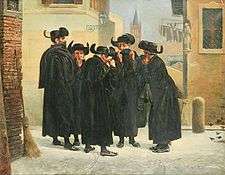Emanuel Salomon Friedberg-Mírohorský

Emanuel Salomon Friedberg-Mírohorský (18 January 1829, Prague – 10 December 1908, Prague) was a Czech painter, illustrator, translator, author and officer in the Austrian Army. He was also an advocate of vegetarianism and abstinence. "Mírohorský" was an artistic pseudonym that means the same thing as "Friedberg" (peaceful mountain) in Czech.
Biography
He was born to a well-known family that included several generals of the Austrian Army. His mother died shortly after his birth and he was raised largely by his uncle, Moric Fialka, an army officer and journalist.[1] In 1837, he began taking drawing lessons at the local grammar school that were organized by František Tkadlík and Antonín Mánes from the Academy of Fine Arts. This made him want to be a painter, but his uncle, who occasionally taught at the Theresian Military Academy, insisted he attend that school and become an officer.[1]
.jpg)
He completed his studies in 1846 and returned to Prague where he joined the 28th Infantry Regiment. In 1848, when the Revolutions began, his Regiment fought under the command of Field Marshal Radetzky at the Battle of Custova. He was injured during an engagement near Voltri and was taken back to Prague after a stay in Milan. He returned to duty and was one of the first to be given the Military Merit Cross, for his actions at the Battle of Kápolna.[1]
Over the next few years, he advanced rapidly and married a Colonel's daughter in 1860. He headed the negotiations with the Italian General, Enrico Cialdini, whose troops had illegally crossed the border in 1866. After that, he was transferred to General Headquarters in Zadar. In 1873, he was promoted to Major-General and, in 1878, to Field Marshal.[2] During this time, he painted whenever possible.
Retirement
.jpg)
He retired in 1883, immediately following a gala dinner with Emperor Franz Joseph, where there was some sort of disagreement over the issue of Czech nationalism, but it is not known for certain if that was the cause. After retiring, he was awarded the Order of the Iron Crown and, the following year, was created a Freiherr.[1] He settled in Prague, where he painted, translated foreign literature (he reputedly spoke ten languages) and gave lectures on his favorite topics of abstinence (he was a confirmed non-smoker and teetotaler) and vegetarianism (which he had adopted in 1860).[2] Hydrotherapy later became a subject of interest.

He painted in a wide variety of genres, including battle scenes that were commissioned by the Emperor. His early works are mostly watercolors, due to the difficulty of painting in oils while out in the fields or on the move. In addition, he also illustrated books and, it is believed, provided perhaps thousand of drawings to magazines, which were published anonymously because of their anti-government content. He also had a major showing at the General Land Centennial Exhibition (1891). Most of his paintings were given away to museums, churches, friends and former associates.
His original writings are related to his military service; notably Válečnictví polní a vojenství (a history of warfare, with a few sections written by Miroslav Tyrš). He also contributed articles to Otto's encyclopedia and wrote some plays, but they were not a success. The magazine, Humoristické listy, published by Jan Vilímek, received his financial support.
References
- 1 2 3 4 Brief biography @ Palba.
- 1 2 Biographical notes @ SPH Adopce.
External links
| Wikimedia Commons has media related to Emanuel Salomon Friedberg-Mírohorský. |
- Detailed biography @ Valka
- "A Biographical Sketch" from Světozor (1873)
- Friedberg-Mírohorský @ abART